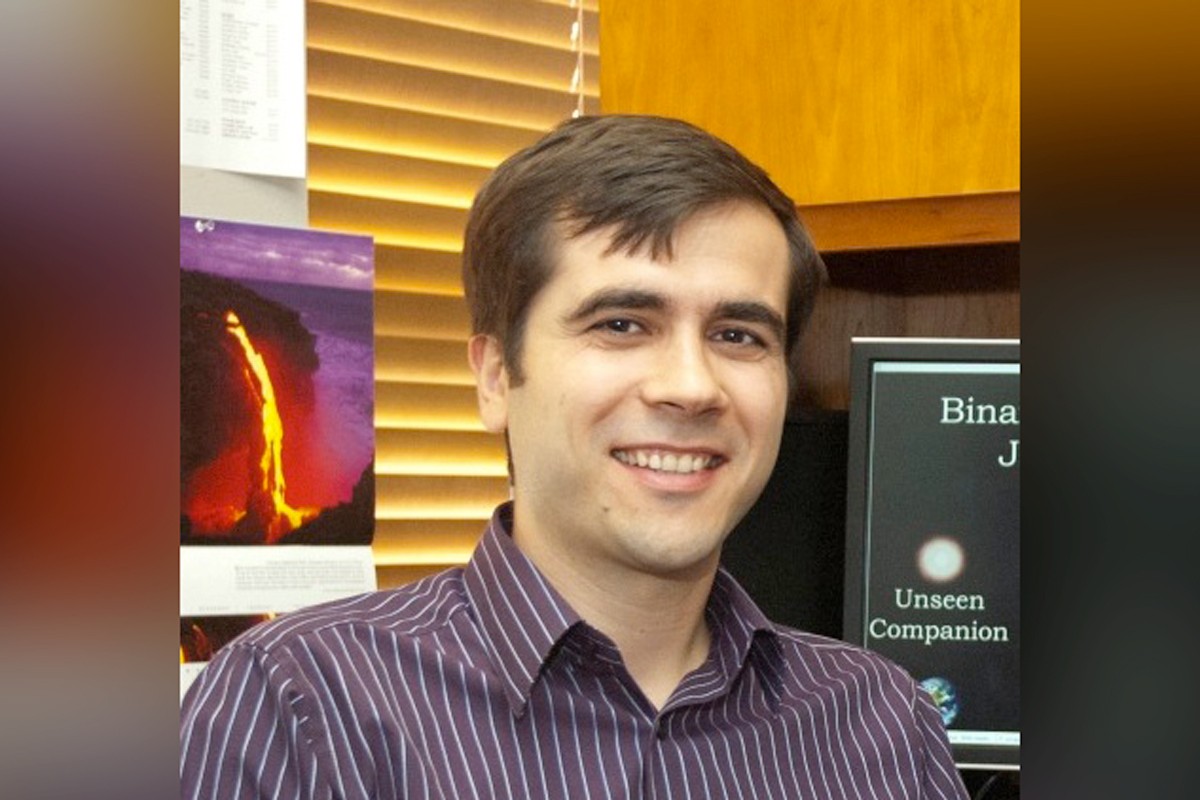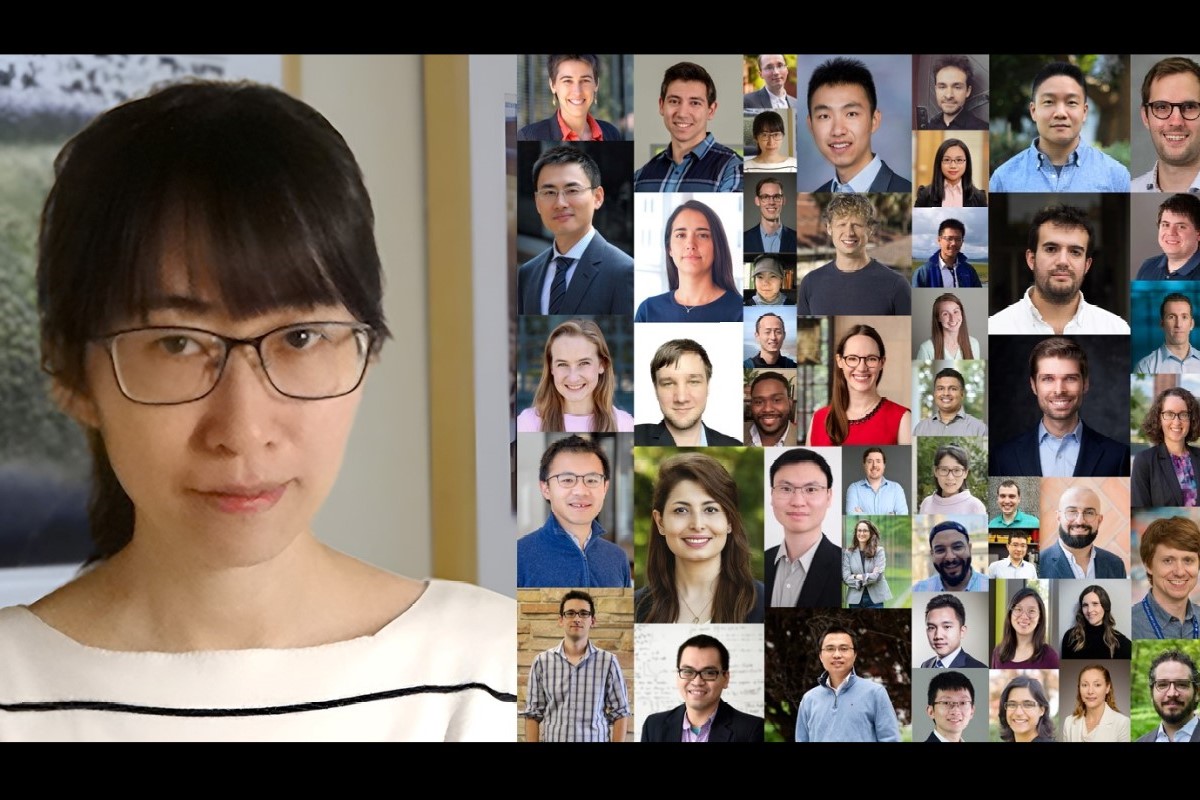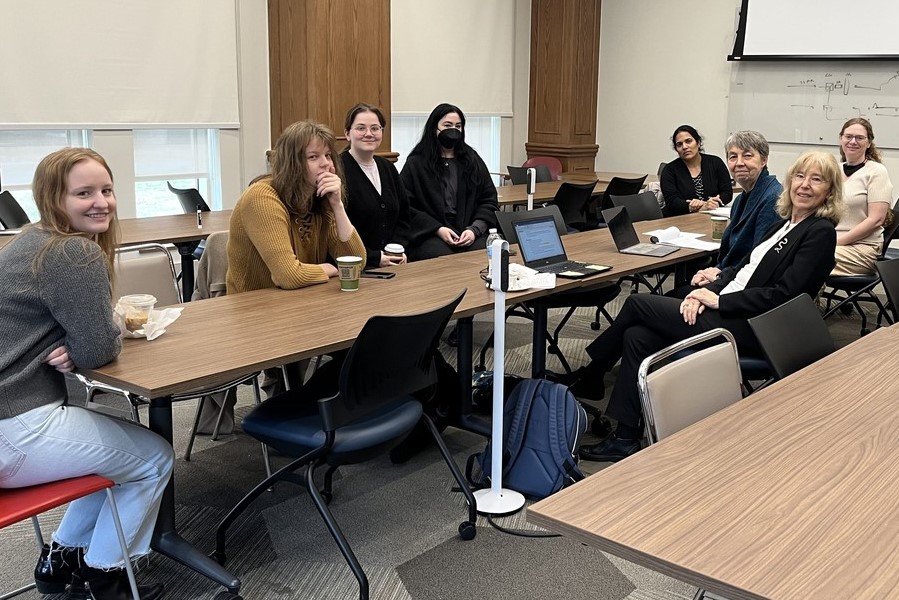
April 08, 2024
Lunar Sooners set up 4 telescopes with solar filters on April 8 2024 to observe the solar eclipse. They collaborated with OU Marketing to host a fantastic event, delivering about 3000 eclipse glasses. Adam Moss MC'ed the event, and we were happy to have President Harroz join and look through our telescopes. Many Lunar Sooners members made this event possible, especially Adam Moss, Heechan Yuk, Chanuntorn Pumpo, Gil Garcia, Stephanie Hall, Theeva Jayanthi, and others.

July 19, 2023
Mukremin Kilic, Ph.D., an associate professor of astrophysics and cosmology in the Homer L. Dodge Department of Physics and Astronomy, is one of 14 scientists selected by NASA to join the Ultraviolet Transient Astronomy Satellite Participating Scientists Program.

December 22, 2023
Bihui Zhu, an assistant professor of atomic, molecular, and optical physics in the Center for Quantum Research and Technology, is one of 48 researchers named to the 2024 Young Investigator Program by the Air Force Office of Scientific Research for her project titled “Harnessing quantum many-body phenomena with long-range interacting AMO platforms.”

In other recent news, Professors Tischler, Santos, and Furis have secured large Federal grants to support new recent themes in the CQRT. Tischler and Santos from the Physics and Astronomy Department at OU in collaboration with Amethyst Research Incorporated (ARI) were granted a Phase II Small Business Technology Transfer (STTR) from the Office of the Secretary of Defense for a total of $1,700,000.00. OU and ARI are working together to develop tunable epsilon-near-zero tunneling diodes in the infrared region to be used as detectors and light sources.

September 12, 2023
Dr. Thirumalai “Venky” Venkatesan, the director of the Center for Quantum Research and Technology at the University of Oklahoma, was elected as Foreign Fellow of the Indian National Science Academy.

March 08, 2023
On March 8th and 9th, the Homer L. Dodge Department of Physics & Astronomy participated in an APS Improving the Climate for Women Site Visit. This program, run by the American Physical Society, sends 4-person groups of external visitors to physics departments around the country with the goal of improving the department climate for women and other marginalized groups.
The ability to create synchronization is the aim of a new research project led through the University of Oklahoma’s Homer L. Dodge Department of Physics and Astronomy and the Center for Quantum Research and Technology. The three-year project is funded through a $1 million grant from the W. M. Keck Foundation and is led by Professor Doerte Blume, Ph.D. Blume is working with CQRT researchers Grant Biedermann, Ph.D., and Alberto Marino, Ph.D., with the support of postdoctoral researchers and graduate and undergraduate students
To read more, view the full news article.
The University of Oklahoma announced today a historic gift that will transform the future of the OU College of Arts and Sciences.
Donated from the family of renowned educator and scientist Homer L. Dodge, a former OU faculty member, department chair and dean, the donation is allocated equally between OU’s College of Arts and Sciences and its Homer L. Dodge Department of Physics and Astronomy – predominantly benefiting student scholarships and research fellowships.
To read more, visit the Homer L. Dodge family donation news article
Prof. Venkatesan and his team published a paper in Nature on September 3rd reporting on an organic electronic device that can make multiple decisions (as many as 71) as opposed to just two for a silicon transistor. Besides consuming ultra- low energy, these devices may enable simpler circuits that would be ideally suited for executing tasks that are suited for artificial intelligence and machine learning or brain- like electronics. To read more, visit "New Molecular Device Has Unprecedented Reconfigurability Reminiscent of Brain Plasticity" at OU's Office of the Vice President for Research and Partnerships and the corresponding publication, "Decision trees within a molecular memristor" in Nature Magazine.
Robert Lewis-Swan, an assistant professor in the Homer L. Dodge Department of Physics and Astronomy in the College of Arts and Sciences at the University of Oklahoma and a CQRT member, contributed to a study led by physicists at the National Institute of Standards and Technology (NIST) published in Science. Read more OU Physicist Contributes to Study to Improve Precision of a Quantum Sensor. Congratulations to Robert and collaborators!

Located on the border between France and Switzerland is a laboratory operated by CERN and the location of a 17-mile (27-kilometre) ring underground, the Large Hadron Collider. This site is where University of Oklahoma physicists Phillip Gutierrez and Howard Baer carry out their work, now supported by a nearly $1.7 million grant from the Department of Energy.
Read more about the high energy physics grant.
Thirumalai “Venky” Venkatesan, director of the Center for Quantum Research and Technology at the University of Oklahoma, is one of 60 outstanding scientists from across the globe selected to join the Royal Society as a fellow. The distinguished group of scientists consists of 52 Fellows, 10 Foreign Members and one Honorary Fellow and were all selected for their exceptional contributions to science. They join the ranks of Stephen Hawking, Isaac Newton, Charles Darwin, Albert Einstein, Lise Meitner, Subrahmanyan Chandrasekhar and Dorothy Hodgkin who all enriched the society with their expertise.
To learn more about Dr. Venkatesan's achievement, read the full article.
HDL undergraduate students Cora De Francesco and Julianna Voelker were selected as First Prize winners in the Multidisciplinary Research category at the 2021 Undergraduate Research Day. Both are advised by HLD Physics and Astronomy professor Karen Leighly. Cora and Julianna received an award of $500 for their research presentation on the subject of FeLoBAL Quasars. Congratulations!
Joseph Choi & Kellen Lawson are recipients of a 2021-2022 Bullard Dissertation Completion Fellowships from OU's Graduate college. The fellowship will provide Joseph & Kellen with a semester's worth of GRA support to work on completing their PhD dissertation.
A hot super-Earth in our neighbourhood promises to be a suitable candidate to test rocky planet atmosphere models.
During the recent two and a half decades, astronomers have discovered thousands of exoplanets made of gas, ice and rock. Only a few of them are Earth-like. However, probing their atmospheres with the currently available instrumentation is challenging at best. Now, astronomers of the CARMENES consortium have published a new study, led by Trifon Trifonov from the Max Planck Institute for Astronomy, which reports the discovery of a hot rocky super-Earth orbiting the nearby red dwarf star Gliese 486. Despite its small separation from the parent star, the planet designated Gliese 486b possibly has retained a part of its original atmosphere. Therefore, Gliese 486b is uniquely suited to examine its atmosphere and interior with the next generation of space-borne and ground-based telescopes. The results are published in the journalScience.
Dr. Vera Maria Passegger, a postdoc in the Homer L. Dodge Department for Physics and Astronomy, contributed to characterizing the planet by deriving fundamental parameters of the host star. An accurate and precise determination of the star's mass, radius, and temperature is essential for constraining the size of the planet itself, and therefore its bulk density, and as well as for estimating the surface temperature.
More details are here: https://www.mpia.de/news/science/2021-05-gliese486b
Adrian Lucy ('14, Astrophysics & History of Science) has accepted a 4-year postdoctoral position at the Space Telescope Science Institute in Baltimore, the science operations center for the Hubble Space Telescope and the soon-to-be-launched JWST. Adrian will divide their time between personal research and functional support for MAST, the Mikulski Archive for Space Telescopes. While at OU, Adrian worked with Prof. Karen Leighly on quasar outflows. They are currently a graduate student at Columbia University, working with Dr. Jeno Sokoloski on finding symbiotic binaries with visible accretion disks. Their research is funded by an NSF graduate fellowship.
Dr. Joseph Tischler joined the Homer L. Dodge Department of Physics and Astronomy as an Associate Professor at the beginning of 2021. He holds an Avenir Foundation Chair in Condensed Matter Physics. His experimental research program focuses on light-matter interactions, including the development of photodetectors, lasers, and new quantum technologies. Welcome Joe!

Graduate student Daniel Vagie, member of the Sinha high energy theory group, recently co-authored a paper published in the prestigious journal Physical Review Letters. Collaborating with researchers at UCLA, Penn State, and IPMU (Japan), Vagie probed the fundamental question of baryogenesis.
“When the Universe began, there were equal amounts of matter and anti-matter. Then something happened in the first few seconds, and all the anti-matter essentially disappeared. What happened is a mystery - but it’s why we exist. The community calls it baryogenesis and it’s one of the biggest problems in fundamental physics,” says Prof. Sinha, who was not a part of the study. “Daniel published four papers with our group and then struck out on his own. The hallmark of a successful graduate career is an independent student. The fact that Daniel reached out to researchers at other institutions and co-authored this important paper with them is a matter of great pride for our group,” he added.
There are a few major paradigms within which baryogenesis is studied. One of them, called Electroweak Baryogenesis, operates near the energy scale that is currently being probed by the Large Hadron Collider at CERN, an energy scale that is being intensely studied by OU’s high energy experimentalists and theorists alike. Another theory of baryogenesis, called Affleck-Dine Baryogenesis, operates at much higher energy scales but integrates supersymmetry, another favorite of OU’s theorists.
“The stakes are high: with no clear signatures of Electroweak Baryogenesis emerging at the Large Hadron Collider (for example through deformations of the Higgs sector beyond the Standard Model), we have to keep an open mind. It is very challenging to directly probe Affleck-Dine Baryogenesis, since it operates at much higher energy scales than current or future collider technology will let us probe. But there are indirect ways of getting at this: through the use of gravitational waves. The Affleck-Dine mechanism involves the formation of a condensate that contains the necessary ingredients to explain the matter anti-matter asymmetry. If the condensate fragments into spherically charged lumps called Q-balls, they can live sufficiently long to dominate the energy density of the Universe at very early times. These Q-balls can enhance the primordial gravitational waves predicted by the theory of inflation, as they rapidly decay into unequal amounts of matter and anti-matter," explains Vagie.
According to Prof. Sinha, "In theoretical high energy physics, we value democracy greatly. There are no senior "last authors" or leading "first authors". Author names are almost always alphabetic. Looking at Daniel's paper on arXiv, I notice that they comment "author order determined by coin-flip." Looks like they had a lot of fun! On a more serious note, though, Daniel's research focuses on very deep questions pertaining to the origins of mass and matter. These questions, and the answers we find, will live on forever. They're timeless."
The University of Oklahoma announced today a historic gift that will transform the future of the OU College of Arts and Sciences.
Donated from the family of renowned educator and scientist Homer L. Dodge, a former OU faculty member, department chair and dean, the donation is allocated equally between OU’s College of Arts and Sciences and its Homer L. Dodge Department of Physics and Astronomy – predominantly benefiting student scholarships and research fellowships.
To read more, visit the Homer L. Dodge family donation news article
Prof. Venkatesan and his team published a paper in Nature on September 3rd reporting on an organic electronic device that can make multiple decisions (as many as 71) as opposed to just two for a silicon transistor. Besides consuming ultra- low energy, these devices may enable simpler circuits that would be ideally suited for executing tasks that are suited for artificial intelligence and machine learning or brain- like electronics. To read more, visit "New Molecular Device Has Unprecedented Reconfigurability Reminiscent of Brain Plasticity" at OU's Office of the Vice President for Research and Partnerships and the corresponding publication, "Decision trees within a molecular memristor" in Nature Magazine.
Robert Lewis-Swan, an assistant professor in the Homer L. Dodge Department of Physics and Astronomy in the College of Arts and Sciences at the University of Oklahoma and a CQRT member, contributed to a study led by physicists at the National Institute of Standards and Technology (NIST) published in Science. Read more OU Physicist Contributes to Study to Improve Precision of a Quantum Sensor. Congratulations to Robert and collaborators!
Thirumalai “Venky” Venkatesan, director of the Center for Quantum Research and Technology at the University of Oklahoma, is one of 60 outstanding scientists from across the globe selected to join the Royal Society as a fellow. The distinguished group of scientists consists of 52 Fellows, 10 Foreign Members and one Honorary Fellow and were all selected for their exceptional contributions to science. They join the ranks of Stephen Hawking, Isaac Newton, Charles Darwin, Albert Einstein, Lise Meitner, Subrahmanyan Chandrasekhar and Dorothy Hodgkin who all enriched the society with their expertise.
To learn more about Dr. Venkatesan's achievement, read the full article.
HDL undergraduate students Cora De Francesco and Julianna Voelker were selected as First Prize winners in the Multidisciplinary Research category at the 2021 Undergraduate Research Day. Both are advised by HLD Physics and Astronomy professor Karen Leighly. Cora and Julianna received an award of $500 for their research presentation on the subject of FeLoBAL Quasars. Congratulations!
Joseph Choi & Kellen Lawson are recipients of a 2021-2022 Bullard Dissertation Completion Fellowships from OU's Graduate college. The fellowship will provide Joseph & Kellen with a semester's worth of GRA support to work on completing their PhD dissertation.
A hot super-Earth in our neighbourhood promises to be a suitable candidate to test rocky planet atmosphere models.
During the recent two and a half decades, astronomers have discovered thousands of exoplanets made of gas, ice and rock. Only a few of them are Earth-like. However, probing their atmospheres with the currently available instrumentation is challenging at best. Now, astronomers of the CARMENES consortium have published a new study, led by Trifon Trifonov from the Max Planck Institute for Astronomy, which reports the discovery of a hot rocky super-Earth orbiting the nearby red dwarf star Gliese 486. Despite its small separation from the parent star, the planet designated Gliese 486b possibly has retained a part of its original atmosphere. Therefore, Gliese 486b is uniquely suited to examine its atmosphere and interior with the next generation of space-borne and ground-based telescopes. The results are published in the journalScience.
Dr. Vera Maria Passegger, a postdoc in the Homer L. Dodge Department for Physics and Astronomy, contributed to characterizing the planet by deriving fundamental parameters of the host star. An accurate and precise determination of the star's mass, radius, and temperature is essential for constraining the size of the planet itself, and therefore its bulk density, and as well as for estimating the surface temperature.
More details are here: https://www.mpia.de/news/science/2021-05-gliese486b
Adrian Lucy ('14, Astrophysics & History of Science) has accepted a 4-year postdoctoral position at the Space Telescope Science Institute in Baltimore, the science operations center for the Hubble Space Telescope and the soon-to-be-launched JWST. Adrian will divide their time between personal research and functional support for MAST, the Mikulski Archive for Space Telescopes. While at OU, Adrian worked with Prof. Karen Leighly on quasar outflows. They are currently a graduate student at Columbia University, working with Dr. Jeno Sokoloski on finding symbiotic binaries with visible accretion disks. Their research is funded by an NSF graduate fellowship.
Dr. Joseph Tischler joined the Homer L. Dodge Department of Physics and Astronomy as an Associate Professor at the beginning of 2021. He holds an Avenir Foundation Chair in Condensed Matter Physics. His experimental research program focuses on light-matter interactions, including the development of photodetectors, lasers, and new quantum technologies. Welcome Joe!
View the original event flyer below:
Optical Tweezer Mini Workshop.pdf
The inaugural 2-day workshop brought leading researchers from academia, national laboratories, and industry to OU’s Norman campus in May 2022.
Read more about the CQRT workshop
In January 2020, The University of Oklahoma Norman Campus hosted a regional American Physical Society (APS) Conference for Undergraduate Women in Physics (CUWiP) meeting for undergraduate physics majors in the central region of the United States.
Learn more about the CUWiP meeting